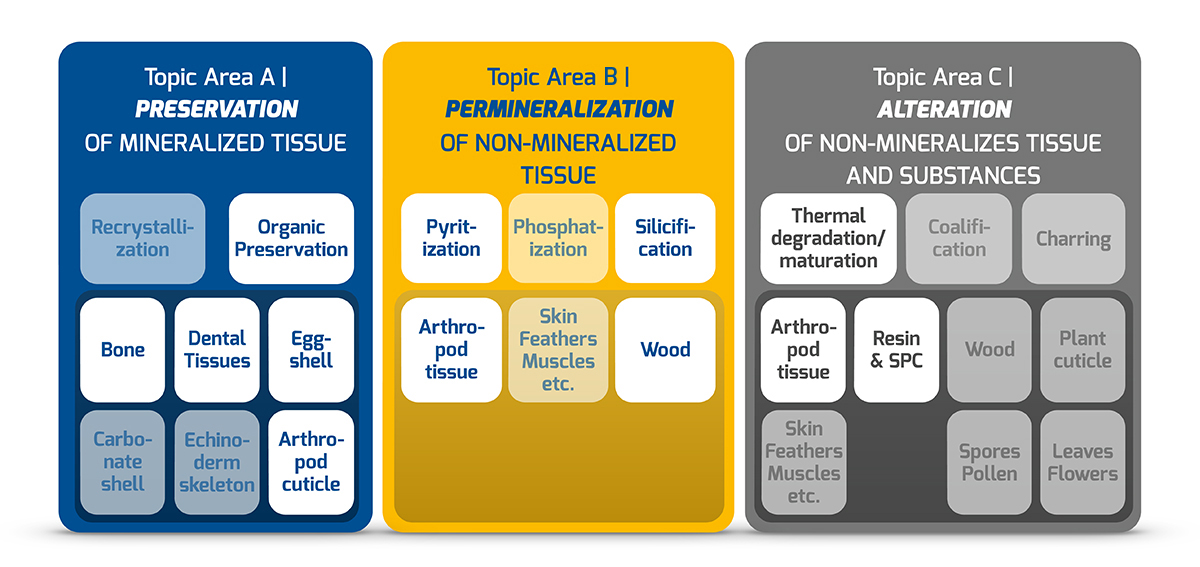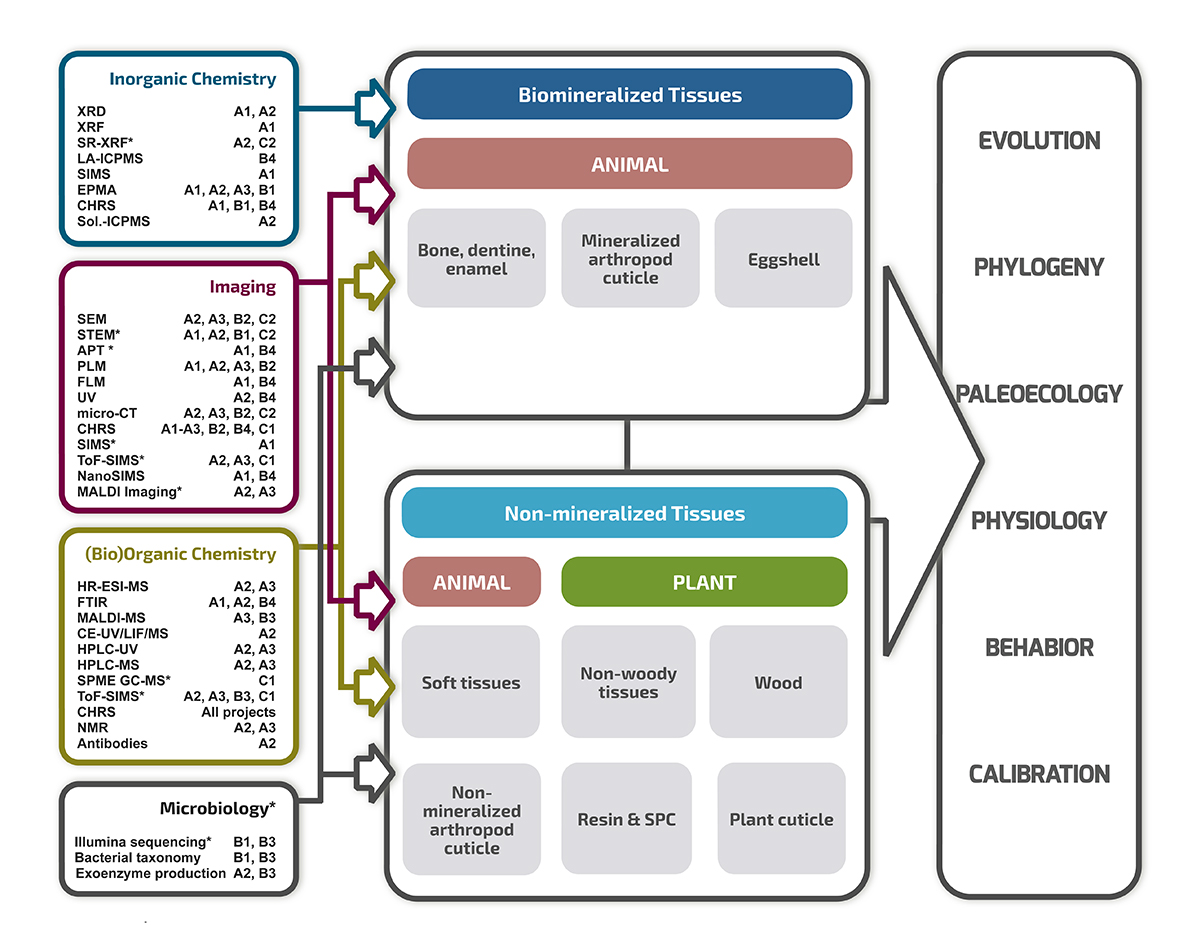DFG Research Unit FOR 2685
"The Limits of the Fossil Record: Analytical and Experimental Approaches to Fossilization"
Introduction
The fossil record is the primary evidence for the history of life on Earth from its beginnings 3.8 billion years ago. However, it is has become increasingly clear that our understanding of the material nature of fossils remains incomplete. Since the processes of fossilization shape the fossil record in a complex manner, we need to understand the limits imposed on the fossil record by fossilization processes if we are to understand the history of life. The last decade has opened up unprecedented opportunities for such research through the development of advanced analytical methods. We are convinced that such research needs to be conducted within an evolutionary framework in order to understand the evolutionary advantages and pathways that went into the selection of a particular biological trait in a fossil organism.

Figure 1 | Topic areas of the research unit. The topic areas are organized by biological tissues and substances and by fossilization process. Bold print indicates topics that are the focus of the first funding period.
Relevance
A deeper understanding of the substance preservation of fossils offers innumerable benefits for the reconstruction of the history of life. Quantitative
analysis of large-scale patterns in the fossil record requires an understanding of any bias in the record that is associated with the transition of organic and inorganic matter from the living environment (the biosphere) to the geological context (the lithosphere). The same understanding is needed for paleoecological studies at the community level. Understanding the biology of ancient organisms equally requires understanding the nature of their fossils. The results of the research unit will have profound applications in the fields of evolutionary biology, phylogeny, calibration of molecular clocks, paleoecology, physiology, and behavior (Figure 2).

Figure 2 | Analytical approaches in FOR 2685. Our analytical approach depends on the kind of fossil tissue. Analytical collaboration takes place via the combination of different analytical methods applied to a specific fossil tissue. Most methods listed are established at one or more lab within the research unit. Astersiks indicate that analyses are done at collaborating institution. See below for methods abbreviations.
Abbreviations of methods:
APT* =atomic probe tomography, CE = capillary electrophoresis, CHRS = confocal hyperspectral Raman spectroscopy, EPMA = electron probe micro-analysis, FLM = fluroescence light microscopy, FTIR = Fourier transformed infrared spectroscopy, NMR = nuclear magnetic resonance spectroscopy of 1H and 13C, HPLC = high performance liquid chromatography, HR-ESI-MS = high resolution electro spray ionization time-of-flight mass spectrometry, LA-ICPMS = laser ablation inductively coupled plasma mass spectrometry, MALDI MS = matrix-assisted laser desorption ionization time-of-flight mass spectrometry, Micro-CT = high- resolution computed x-ray tomography, MS = mass spectrometry, NanoSIMS* = nano-scale secondary ion mass spectrometry, PLM = polarized light microscopy, SEM = scanning electron microscopy, SIMS* = secondary ion mass spectrometry, Sol.-ICPMS = solution inductively coupled plasma mass spectrometry, SPME GC-MS* = solid phase microextraction gas chromatography, SR-XRF* = synchrotron radiation X-ray fluorescence, STEM* = scanning transmission electron microscopy, ToF-SIMS* = time-of-flight secondary ion mass spectrometry, UV = filtered ultraviolet light analysis, including, XRD = X- ray diffraction, XRF = X-ray fluorescence.
Limits of preservation
The objective of FOR 2685 is a deeper understanding of the material nature of fossils from analytical and experimental perspectives. Obtaining this integrative view is not possible without the close cooperation, flow of ideas, and exchange of methods fostered by a research unit that goes beyond what individual researchers and bilateral collaborations could deliver.
In particular, we want to explore the limits of preservation, especially at the histological, cytological, and molecular levels. This will be achieved by pushing both the limits of the analytical detection of organic macromolecules and other compounds in fossils and by understanding the processes that lead to preservation at sub-organismic levels. Understanding the processes of fossilization not only requires state-of-the-art analytical techniques, but also experimentation under controlled physicochemical conditions. Obviously, fossils from conservation deposits such as the Hunsrück Slate will play an important role in this research program, but fossils from other deposits are of equal interest as long as they offer some organic preservation potential, such as insects from different amber deposits or any kind of fossil bone.
Processes of Fossilization
The commonly recognized processes of fossilization – silicification (e.g., of wood), pyritization (e.g., of arthropods), phosphatization (e.g., of arthropods and vertebrate soft tissues), permineralization (e.g., of bone), and alteration of organics (e.g., amber, vertebrate integument, coalification of plant material) – are key processes that will be studied analytically and experimentally. The first funding period (FP) is focused on understanding simpler processes using advanced analytical and experimental approaches, while the second FP will look at more complex types of fossilization and search for common principles in the mineralization and preservation of organic compounds.
FOR 2685 will establish standard research protocols across the disciplines and groups of organisms to provide a deeper understanding of the origin and nature of exceptional fossil deposits and to develop a synthetic view of fossilization that goes beyond classical taphonomy to discover basic principles that underlie the preservation of organisms and their parts. We are in a very good position to achieve this synthetic view because of the broad and profound expertise represented in the unit, covering most, if not all fields concerning fossilization. In fact, this goal cannot be reached without the close collaboration of paleontologists, microbiologists, organic chemists, mineralogists, geochemists, pharmacists, and petrologists.







